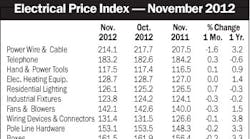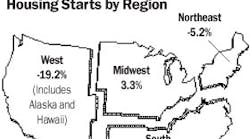Latest from Mag
People - Dec 21, 2012
Obituaries - Dec 21, 2012
November EPI Index Shows No Change
Housing Starts Dip 4% in November
Electrical Marketing - December 21, 2012
Around the Industry - Dec 21, 2012
Copper prices fell this week to their lowest point in at least a year and a half amid fears that long-term weakness in the global economy will bring reduced demand.
On Wednesday, Oct. 8, copper spot prices on the Comex division of the New York Mercantile Exchange closed at $2.3665 per pound and futures contracts for December delivery were $2.3550, a drop of about 7 percent on the day for both. Three-month copper contracts on the London Metal Exchange posted their second-largest one-week drop to $5,977.5 per metric ton.
Persistent supply concerns had supported copper prices through much of the turmoil affecting the rest of the world’s base-metals markets, but growing expectations of a slowdown in demand from China, which consumes about 80 percent of the world’s copper production, have altered the picture.
Copper prices have fallen by more than 40 percent since a peak of $4.054 on July 2. Prices firmed slightly on Thursday, Oct. 9, the day after the central banks of several nations announced coordinated interest-rate cuts, but metals analysts saw no reason to believe the prices wouldn’t continue to fall.
The website of Business News Americas, Chile, quoted one metals analyst, Gayle Berry of Barclay’s Capital, saying she expected the price of copper to bottom-out sometime in the first quarter of 2009. Other analysts said continuing supply uncertainty offset by softening demand make predicting prices over the next two years nearly impossible.
The International Copper Study Group, Lisbon, Portugal, released its forecast for 2008-2009 on Oct. 8. The report predicts a net surplus of 100,000 metric tons for 2008 overall due to weakening demand in China, the 15 European Union countries and the United States, after a shortfall in the first half of 2008. The group expects the surplus to grow to 275,000 metric tons in 2009, but cautioned that the current financial turmoil — which could both reduce demand and reduce the availability of credit for production increases — made the net impact uncertain.

